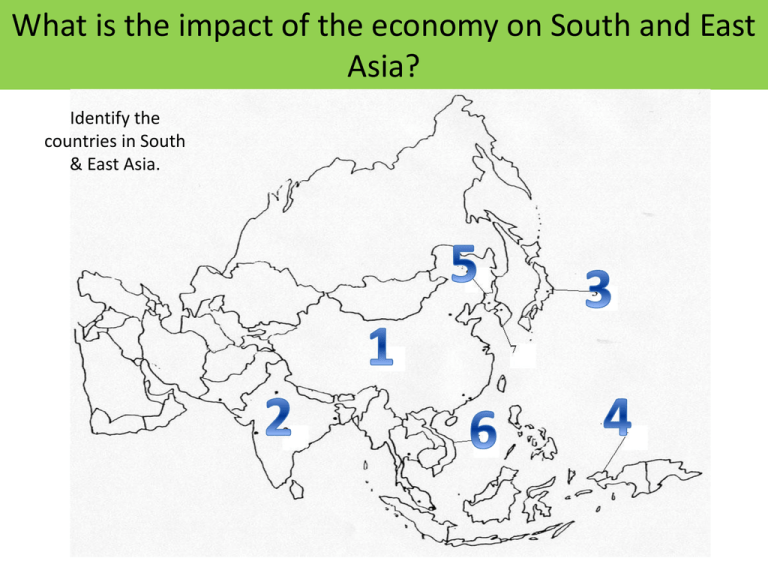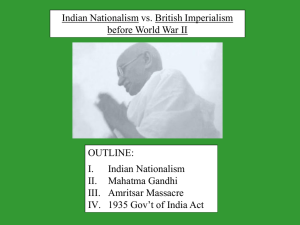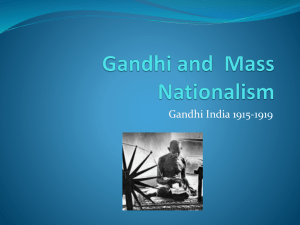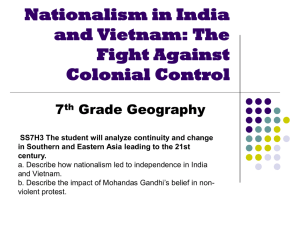Weekly PowerPoint
advertisement

What is the impact of the economy on South and East Asia? Identify the countries in South & East Asia. What is the impact of the economy on South and East Asia? • Complete the Study Guide provided to you. • You may use: – Your notes from last week – Your CRCT Coach Book – Academic discussion with your partner SS7E8: The student will analyze different economic systems in China, India, Japan, and North Korea. SS7E9: The student will explain how voluntary trade benefits buyers and sellers in Southern and Eastern Asia. SS7E10: The student will describe the factors that influence economic growth and examine their presence or absence in India, China, and Japan. What is the impact of the economy on South and East Asia? • Unit Test – There should be no talking - Talking will result in a 0. After the Test: My Superhero Page Economic problems plague many countries around the world. Draw a superhero that will save the day in areas facing economic struggles and complete the statements on the worksheet. Be creative! Use the supplies to make it colorful & ready to be posted anywhere in the school! SS7E8: The student will analyze different economic systems in China, India, Japan, and North Korea. SS7E9: The student will explain how voluntary trade benefits buyers and sellers in Southern and Eastern Asia. SS7E10: The student will describe the factors that influence economic growth and examine their presence or absence in India, China, and Japan. How did nationalism lead to independence in India? SS7H3: The student will analyze continuity and change in Southern & Eastern Asia leading to the 21st century. Your Task! Write one sentence that tells how you think the words in the Word Splash are related. How did nationalism lead to independence in India? SS7H3: The student will analyze continuity and change in Southern & Eastern Asia leading to the 21st century. • Watch the video, Men of Our Time: Gandhi. • Complete the Inside the Mind of Gandhi sheet: – Write at least 4 facts and 5 symbols that you feel are most important based on your viewing of the video. How did nationalism lead to independence in India? SS7H3: The student will analyze continuity and change in Southern & Eastern Asia leading to the 21st century. Now… Tell me - - how are these words related? Were your first assumptions correct? Share your thoughts! How did nationalism lead to independence in India? SS7H3: The student will analyze continuity and change in Southern & Eastern Asia leading to the 21st century. • Create a vocabulary foldable. nationalism Gandhi • Label each section as you see here. non-violence independence • Define the words. – What do you remember from yesterday? How did nationalism lead to independence in India? SS7H3: The student will analyze continuity and change in Southern & Eastern Asia leading to the 21st century. Check your answers! Nationalism: Gandhi: The belief that people should be the lawyer who became the famed loyal to those with whom they leader of the Indian revolts against share common history customs, the British rule through his origins, and sometimes language or philosophy of non-violent protest religion non-violence: Independence: absence of violence exercise self-government How did nationalism lead to independence in India? SS7H3: The student will analyze continuity and change in Southern & Eastern Asia leading to the 21st century. Watch the video: Gandi – Tool: The Pot 1) Gandhi said, “We will not ____ anyone or ____ anyone!” 2) “They will have my dead body but never my _____.” 3) What did they do to the people who were gathered peacefully in the courtyard? 4) The newspaper headline said that “Mahatmas Gandhi would _____ until death”. 5) Gandhi was told that in all the temples they vowed to never _____. A feeling of nationalism began to surface in India in the 1800’s . People began to be upset that their country was a part of the British colonial empire. They were second class citizens in their own country. Indians growing of fine cotton and weaving were considered traditional crafts. Indians were forced to send all of their cotton to Britain and then had to buy the finished cloth from the British factories. This was like the American colonies before the revolution. S.G.: As a reaction to British rule, Indian nationalism began in the 1800’s. SS7H3: The student will analyze continuity and change in Southern & Eastern Asia leading to the 21st century. S. G.: One of the early goals of the Indian National Congress was they wanted greater independence from British control. SS7H3: The student will analyze continuity and change in Southern & Eastern Asia leading to the 21st century. S. G.: To encourage the British to grant India greater freedom after the war, the Indians helped the British in World War I. SS7H3: The student will analyze continuity and change in Southern & Eastern Asia leading to the 21st century. Indian political leader Mahatma Gandhi (1869-1948) believed in nonviolence, or satyagraha, to achieve political change. SG: One of Gandhi’s main strategies in dealing with the British was to insist his followers use non-violence. SS7H3: The student will analyze continuity and change in Southern & Eastern Asia leading to the 21st century. After becoming leader of the Indian National Congress in 1921, Mahatma Gandhi rallied peasants, farmers, and workers in India to help the country become independent of foreign rule. SG: Gandhi urged Indians during World War II to not choose a side during the war. SS7H3: The student will analyze continuity and change in Southern & Eastern Asia leading to the 21st century. S.G.: Gandhi’s plan was to refuse to obey unjust British laws. This was called civil disobedience. SS7H3: The student will analyze continuity and change in Southern & Eastern Asia leading to the 21st century. SS7H3: The student will analyze continuity and change in Southern & Eastern Asia leading to the 21st century. SS7H3: The student will analyze continuity and change in Southern & Eastern Asia leading to the 21st century. S. G.: The Indians were offered the dominion statue in the 1930s but they refused it because they wanted total freedom from Great Britain. SS7H3: The student will analyze continuity and change in Southern & Eastern Asia leading to the 21st century. S. G.: Independence finally came in 1947 but the Indians were unhappy because the country had been divided due to religious differences. S. G.: Religion determined where people would live in the new states that were created after independence. SS7H3: The student will analyze continuity and change in Southern & Eastern Asia leading to the 21st century. Eureka!: The India File: The Struggle for Freedom Your Task: From the information presented in the video, create a timeline to emphasize India’s political history, from a divided country to a British colony, and ultimately an independent democracy. Divided Country Info British Colony Info Independent Colony Info SS7H3: The student will analyze continuity and change in Southern & Eastern Asia leading to the 21st century. Let’s Chat - - What do you know? • Help Me Create My Timeline! – Give me specific facts to add to the timeline below. Divided Country Info British Colony Info SS7H3: The student will analyze continuity and change in Southern & Eastern Asia leading to the 21st century. Independent Colony Info How did nationalism lead to independence in India? SS7H3: The student will analyze continuity and change in Southern & Eastern Asia leading to the 21st century. • Quiz Time! – You may use your vocabulary foldable. – You may use your notes from Wednesday and Thursday. – Take your time & be sure to answer the specific questions presented! How did nationalism lead to independence in India? SS7H3: The student will analyze continuity and change in Southern & Eastern Asia leading to the 21st century. • Read the article, Gandhi • Code the text as you read • Answer the questions based on the evidence obtained from your reading of the text ! = Surprise me ? = Question I = Important K = Key T = Talk H = Huh? C = Cause E = Effect L = Learned something F = Fact O = Opinion How did nationalism lead to independence in India? SS7H3: The student will analyze continuity and change in Southern & Eastern Asia leading to the 21st century. • Write a brief letter to Gandhi to let him know whether or not you want to join his cause. – Explain your reasoning and provide specific evidence from the article. – Example: • I really admire your desires to bring forth independence through nonviolent acts. There is too much violence in the world today, and I think your approach will be much more effective! Dear Gandhi,








